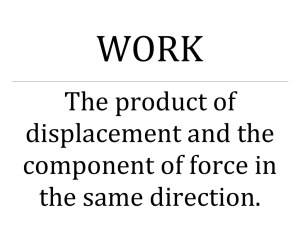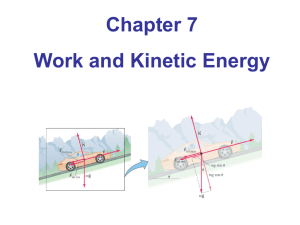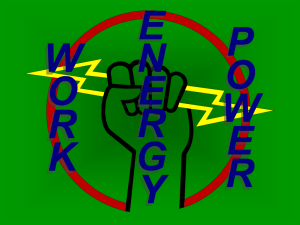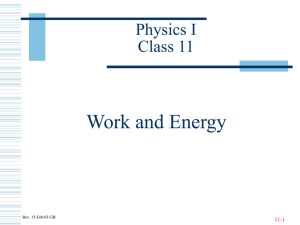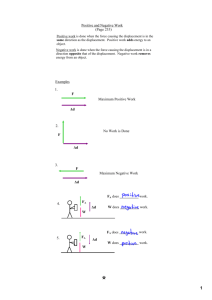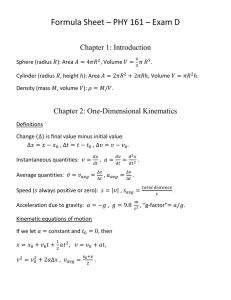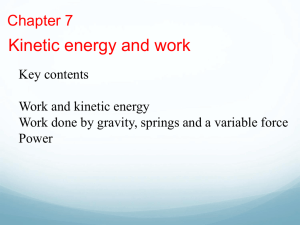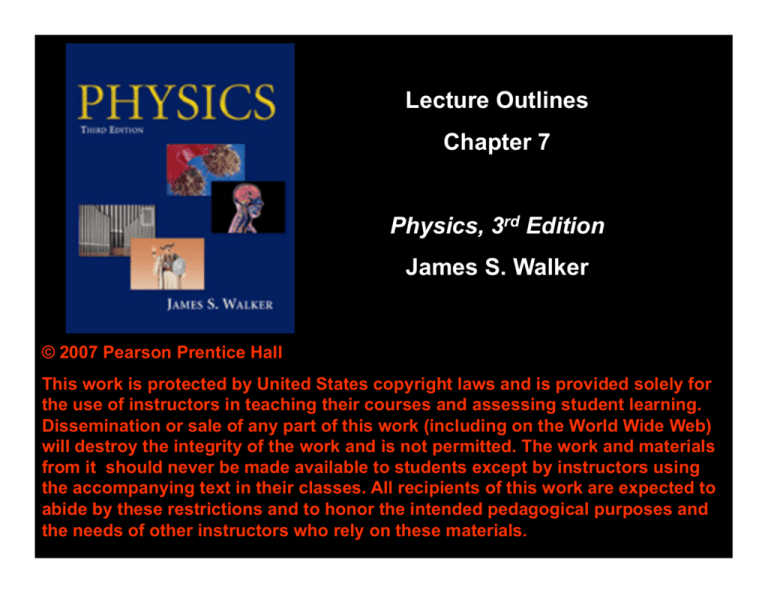
Lecture Outlines
Chapter 7
Physics, 3rd Edition
James S. Walker
© 2007 Pearson Prentice Hall
This work is protected by United States copyright laws and is provided solely for
the use of instructors in teaching their courses and assessing student learning.
Dissemination or sale of any part of this work (including on the World Wide Web)
will destroy the integrity of the work and is not permitted. The work and materials
from it should never be made available to students except by instructors using
the accompanying text in their classes. All recipients of this work are expected to
abide by these restrictions and to honor the intended pedagogical purposes and
the needs of other instructors who rely on these materials.
Chapter 7
Work and Kinetic Energy
Units of Chapter 7
• Work Done by a Constant Force
• Kinetic Energy and the Work-Energy
Theorem
• Work Done by a Variable Force
• Power
7-1 Work Done by a Constant Force
The definition of work, when the force is
parallel to the displacement:
(7-1)
SI unit: newton-meter (N·m) = joule, J
7-1 Work Done by a Constant Force
7-1 Work Done by a Constant Force
If the force is at an angle to the displacement:
(7-3)
7-1 Work Done by a Constant Force
The work can also be written as the dot
product of the force and the displacement:
7-1 Work Done by a Constant Force
The work done may be positive, zero, or
negative, depending on the angle between the
force and the displacement:
7-1 Work Done by a Constant Force
If there is more than one force acting on an
object, we can find the work done by each force,
and also the work done by the net force:
(7-5)
7-2 Kinetic Energy and the Work-Energy
Theorem
When positive work is done on an object, its
speed increases; when negative work is done,
its speed decreases.
7-2 Kinetic Energy and the Work-Energy
Theorem
After algebraic manipulations of the equations
of motion, we find:
Therefore, we define the kinetic energy:
(7-6)
7-2 Kinetic Energy and the Work-Energy
Theorem
Work-Energy Theorem: The total work done on an
object is equal to its change in kinetic energy.
(7-7)
7-3 Work Done by a Variable Force
If the force is constant, we can interpret the
work done graphically:
7-3 Work Done by a Variable Force
If the force takes on several successive constant
values:
7-3 Work Done by a Variable Force
We can then approximate a continuously varying
force by a succession of constant values.
7-3 Work Done by a Variable Force
The force needed to stretch a spring an amount
x is F = kx.
Therefore, the work
done in stretching
the spring is
(7-8)
7-4 Power
Power is a measure of the rate at which work is
done:
(7-10)
SI unit: J/s = watt, W
1 horsepower = 1 hp = 746 W
7-4 Power
7-4 Power
If an object is moving at a constant speed in the
face of friction, gravity, air resistance, and so
forth, the power exerted by the driving force can
be written:
(7-13)
Summary of Chapter 7
• If the force is constant and parallel to the
displacement, work is force times distance
• If the force is not parallel to the displacement,
• The total work is the work done by the net
force:
Summary of Chapter 7
• SI unit of work: the joule, J
• Total work is equal to the change in kinetic
energy:
where
Summary of Chapter 7
• Work done by a spring force:
• Power is the rate at which work is done:
• SI unit of power: the watt, W

